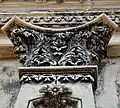| Panam Nagar | |
|---|---|
| Native name পানাম নগর | |
 | |
| Location | Sonargaon, Narayanganj, Bangladesh |
| Coordinates | 23°39′22″N 90°36′15″E / 23.6560°N 90.6042°E |
| Founded | Late 13th century |
| Architectural style(s) | British, Mughal |
 Location of Panam Nagar in Bangladesh | |
Panam City (Bengali: পানাম নগর; romanised:panam nogor) was an ancient city, the archaeological ruins of which is situated at Sonargaon, Narayanganj in Bangladesh. It is one of the earliest cities in Bangladesh that is still standing.[1]
Among the three cities of the time period: Boro nagar (Big City), Khas Nagar and Panam Nagar; Panam Nagar was the most attractive one.[2] The city area which covers roughly 20 square kilometres (7.7 sq mi), consists of several historical buildings built centuries ago connected with the history of Baro-Bhuyan. Reportedly, this is one of the most visited tourist spots in Bangladesh.
As the capital of the fifteenth-century Bengal ruler Isa Khan, the city was once an important trading and political center. Although the buildings are now mostly in ruins, the historical city boasts architectural examples from the Sultanate, Mughal, and British Colonial periods.
The historic city, located near the present-day capital of Dhaka, includes several Mughal monuments—among them the Sonakanda River Fort, the Panch Pir Mazar Shrine, and Ibrahim's and Abdul Hamid's Mosque. British colonial architecture preserved in Sonargaon includes the Ananda Mohan Piddar House, and other street-front houses. For travelers making their way along the 2,500-kilometre-long (1,600 mi) Grand Trunk Road from Peshawar in the Hindu Kush, Sonargaon marked the end of the line.
Threats to the site include flooding, vandalism, unauthorized occupation, illegal development etc. The historical buildings are becoming increasingly dilapidated with age and there are no signs of any significant restoration attempts in order to preserve the site.
Gallery
 An abandoned building showcasing eclectic architectural influences
An abandoned building showcasing eclectic architectural influences.JPG.webp) Kashinath House (#38), built in 1898 AD
Kashinath House (#38), built in 1898 AD Choto Sardar Bari
Choto Sardar Bari Hindu religious inscription on stucco relief under a Mughal-style arch.
Hindu religious inscription on stucco relief under a Mughal-style arch. Stucco ornament over a door
Stucco ornament over a door Column capital with stucco ornament
Column capital with stucco ornament.jpg.webp) Ornate ceiling
Ornate ceiling Mosaic plaque by a front-door
Mosaic plaque by a front-door Checkered floor interior
Checkered floor interior Cast iron column and arch opening with floral ornamentation (building #31, built in 1928 AD)
Cast iron column and arch opening with floral ornamentation (building #31, built in 1928 AD).jpg.webp) Mughal-style arch over a door.
Mughal-style arch over a door..jpeg.webp) Islamic-style facade.
Islamic-style facade.